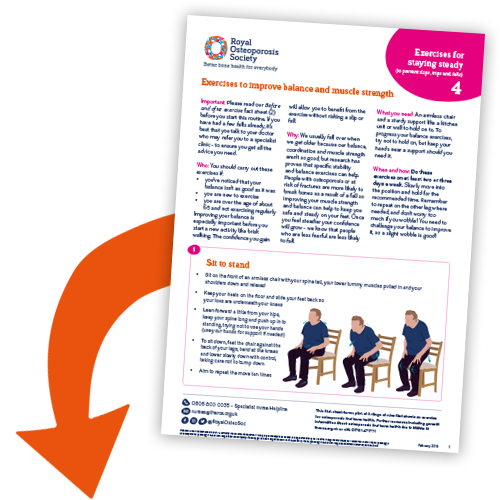
Exercises to improve balance
We often fall over when we get older because our balance, coordination and muscle strength aren’t so good. But research has shown that specific stability and balance exercises can help.

Download our fact sheet
Exercises to improve balance and muscle strengthPeople with osteoporosis or at risk of fractures are more likely to break bones as a result of a fall. So improving your muscle strength and balance can help to keep you safe and steady on your feet.
Once you feel steadier, your confidence will grow – we know that people who are less fearful are less likely to fall.
To practise these exercises, follow the film above or download the accompanying fact sheet, 'Exercises to improve balance and muscle strength'.
Do these exercises if:
- your balance isn’t as good as it was
- you are new to exercise
- you are over the age of about 65 and not exercising regularly.
Improving your balance is especially important before you start a new activity like brisk walking. The confidence you gain will allow you to benefit from the exercise without risking a slip or fall.
What you'll need
An armless chair and a sturdy support like a kitchen unit or wall to hold on to. To progress your balance exercises, try doing them without holding on to anything. Keep your hands near a support in case you need it.
When and how
Do these exercises on at least two or three days a week. Move slowly into the positions and hold for the recommended time. Remember to repeat on the other leg where needed, and don’t worry too much if you wobble! You need to challenge your balance to improve it, so a slight wobble is a good thing.
Before you start
If you are new to exercise or worried about other health problems, speak to your doctor, other healthcare professional, or an exercise instructor.
Warm up properly before exercising to get your joints and muscles ready and to prevent injury.
If you need some extra encouragement, read the information in our fact sheet, 'About exercise for osteoporosis and bone health'. This explains the different ways that exercise and physical activity help with bone health and osteoporosis. It can help you think about how the benefits apply to you, and how the different types of exercise can help your bone health.
See our How to exercise safely for your bones film
After exercise
Do some further cool down moves to increase your flexibility and return your breathing and heart rate back to resting levels.
Watch our discussion:
We looked at ways of reducing the risk of falls to maintain bone health, independence and quality of life. We were joined by Professor Tahir Masud, Professor Dawn Skelton and Julie Whitney. This film is part of our #BoneMatters series of events
 Search
Search
 Login
Login


